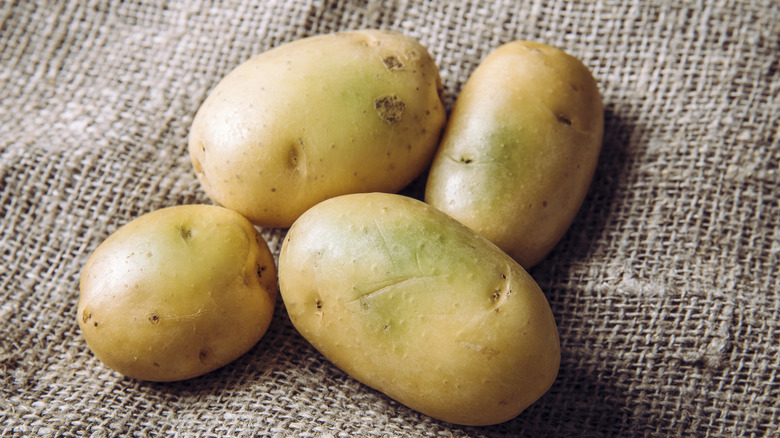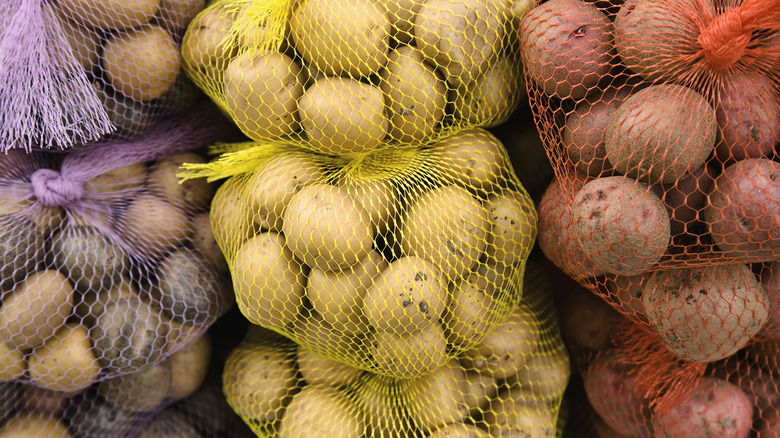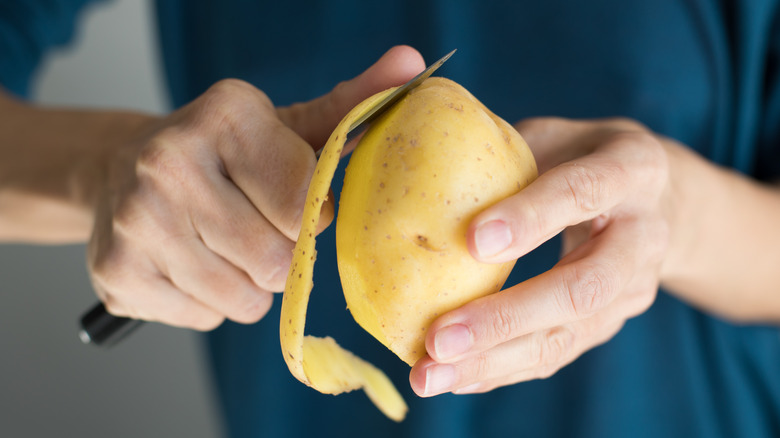The Safety Tips You Need To Confidently Eat Green Potatoes
When it comes to fruits and vegetables, green is typically good. Green veggies are treasure troves of vitamins, minerals, and antioxidants— the cornerstones of good health. The green color in fruits (not counting kiwis, green grapes, pears, and honeydew melons) typically indicates that they were picked a little early and will ripen up in no time. Of course, there are exceptions. If you encounter strawberries that are green, they're likely to be fuzzy as well, and consuming them would be inadvisable. As for green potatoes? Before you go turning them into something like baked french fries, you should know that the teal tint doesn't mean they were harvested early.
The green you see on potatoes signifies the presence of chlorophyll, the same stuff that makes plants green. On its own, chlorophyll is perfectly harmless and can even be beneficial, as reported by the MD Anderson Cancer Center. However, potatoes only turn green when they've been exposed to too much light (remember, they grow underground), and when this happens, the tubers also tend to develop two toxins called solanine and chaconine. While naturally present in several vegetables, including potatoes, high levels of these substances can be dangerous. When damaged potatoes are stored improperly, these levels increase.
Green isn't always good
High levels of solanine and chaconine can result in what's called solanine poisoning, according to researchers at Mount Sinai Hospital. Symptoms of such poisoning are very uncomfortable, to say the least, and should be addressed immediately. They can include headaches, stomach pain, hypothermia, blurred vision, and even death in the most extreme cases. Before you swear off potatoes forever, it's important to note that, while such poisoning still happens, it's not as common as it once was since society has become more aware of safety measures when it comes to growing and storing vegetables.
Practices, methods, and safety measures are in place at large scale potato farms to avoid such occurrences as much as possible. Still, we've all spotted a green potato or two in our bags or baskets of spuds. We may have even eaten them with no adverse effects. A green color on the skin of potatoes is certainly the first sign that they've been improperly stored, but sometimes even their taste can indicate an issue. Solanine has a very bitter taste, especially in high levels, so if you sense something weird in your homemade french fries, it's probably best to discard the batch. It's understandable if you want to ditch any potato that shows even a hint of green color, but, surprisingly, that's not altogether necessary. With a little preparation, you can still consume these types of potatoes safely.
Peel away until the green is gone
Ideally, you'll want to avoid any green coloration on your potatoes, and one way to minimize the chances of encountering this issue is by purchasing them from a reputable farmer's market. Produce from such markets tends to be the freshest and recently harvested, decreasing the chances that it has been sitting around for long periods of time. But even grocery store potatoes are generally safe. If you do get a green-tinted tuber, simply peel off the green skin, any new shoots, and any flesh that may have a green color on it. These are basically the areas where solanine "lives." Once you're down to the normal colored vegetable, you can prepare it as desired.
If you're storing your potatoes, be sure to keep them out of the sunlight and in a dark, cool location, ideally someplace with a temperature between 45 and 50 degrees Fahrenheit, like a root cellar, or even a cool basement. They should keep for several weeks, but remember, food can sometimes have a sneaky way of trying to harm you, so always prioritize your safety. If you find it challenging to eliminate the greenish tint or if something tastes off, it's best to err on the side of caution and discard it. There are plenty of other potatoes available for you to choose from.



